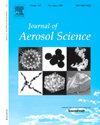In-vitro visualization of aerosol deposition by laser-induced fluorescence in a human airway model
IF 2.9
3区 环境科学与生态学
Q2 ENGINEERING, CHEMICAL
引用次数: 0
Abstract
This study presents the first in-vitro visualization of aerosol deposition from the trachea up to the 10th bifurcation in a transparent airway model. The airway model simulates a representative respiratory tract of the left lower lobe and consists of all 23 generations of a human lung. Laser- induced fluorescence (LIF) was used to investigate the temporal and spatial deposition behavior of aerosols generated by a jet nebulizer along the representative airway. The in-situ measured LIF signal correlates to the amount of deposited aerosol during spontaneous breathing. By the means of LIF-image post-processing the temporal course of the LIF signal in each of the first eight bifurcations is correlated to the main aerosol deposition mechanisms, i.e. inertial impaction and gravitational settling, in the conductive airways. Depending on the time point in the respiratory cycle either one of both deposition mechanisms dominates the current aerosol deposition. The spatial analysis over eight subsequent bifurcations shows the diminishing influence of the inertial deposition mechanism over deeper bifurcations. Further, the duration of gravitational settling decreases over the bifurcations depending on the accompanying airway diameters of each bifurcation. The introduction of the dimensionless Froude number allows the comparison of the measured aerosol deposition to existing research and demonstrates that the proposed threshold limit in literature of Froude <5 matches well to the gravitational settling regime observed in the transparent airway. For Froude >5 mainly the inertial impaction is observed as mechanism for aerosol deposition in this set-up. An error analysis is performed for evaluating the influence of the low relative humidity of the inhaled air on the aerosol evaporation and deposition. This feasibility study shows the capability of the measurement method in combination with the airway model to resolve the aerosol deposition up to the eighth bifurcation. In future, this analysis should be extended to higher airway generations by microscopic LIF imaging to evaluate the deposition mechanisms in all 23 generations of the transparent airway model.

激光诱导荧光在人体气道模型中气溶胶沉积的体外可视化
本研究首次展示了透明气道模型中从气管到第10分岔的气溶胶沉积的体外可视化。该气道模型模拟了左下叶的代表性呼吸道,由人类肺的所有23代组成。采用激光诱导荧光(LIF)研究了喷射雾化器产生的气溶胶沿代表性气道的时空沉积行为。原位测量的LIF信号与自发呼吸过程中沉积的气溶胶量有关。通过对LIF图像的后处理,在前8个分支中,LIF信号的时间过程与主要的气溶胶沉积机制,即惯性撞击和重力沉降,在导电气道中相关。根据呼吸周期的时间点,这两种沉积机制中的任何一种都主导着当前的气溶胶沉积。对八个后续分岔的空间分析表明,惯性沉积机制对更深分岔的影响逐渐减弱。此外,重力沉降的持续时间在分叉上减少,这取决于每个分叉的气道直径。引入无因次弗劳德数可以将测量到的气溶胶沉降与现有研究进行比较,并证明弗劳德5文献中提出的阈值限制与透明气道中观测到的重力沉降情况很好地匹配。对于弗鲁德>;5,在这个装置中,主要观察到惯性冲击作为气溶胶沉积的机制。对吸入空气相对湿度低对气溶胶蒸发和沉积的影响进行了误差分析。这一可行性研究表明,该测量方法与气道模型相结合,能够解决到第8分岔的气溶胶沉积。未来,该分析应通过显微LIF成像扩展到更高代的气道,以评估所有23代透明气道模型的沉积机制。
本文章由计算机程序翻译,如有差异,请以英文原文为准。
求助全文
约1分钟内获得全文
求助全文
来源期刊

Journal of Aerosol Science
环境科学-工程:化工
CiteScore
8.80
自引率
8.90%
发文量
127
审稿时长
35 days
期刊介绍:
Founded in 1970, the Journal of Aerosol Science considers itself the prime vehicle for the publication of original work as well as reviews related to fundamental and applied aerosol research, as well as aerosol instrumentation. Its content is directed at scientists working in engineering disciplines, as well as physics, chemistry, and environmental sciences.
The editors welcome submissions of papers describing recent experimental, numerical, and theoretical research related to the following topics:
1. Fundamental Aerosol Science.
2. Applied Aerosol Science.
3. Instrumentation & Measurement Methods.
 求助内容:
求助内容: 应助结果提醒方式:
应助结果提醒方式:


